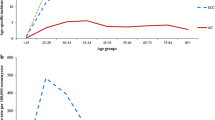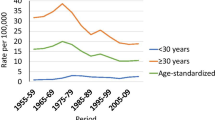Abstract
Objective
Differences in cervical cancer incidence rates by race/ethnicity persist in the United States. We examined these differences by histologic type and by various patient and socioeconomic characteristics.
Methods
Thirteen U.S. cancer registries were used to identify women 20–79 years of age diagnosed from 1992 to 2003 with invasive cervical cancer. Age-adjusted incidence rates and annual percent changes were calculated for four different races/ethnicities (Non-Hispanic whites, Hispanic whites, African-Americans, and Asians/Pacific Islanders) for cervical cancer overall, squamous cell carcinoma (SCC), and adenocarcinoma (AC).
Results
Hispanic whites had the highest incidence rate of cervical cancer overall (24.2/100,000), SCC (18.3/100,000), and AC (4.6/100,000). Non-Hispanic whites had the lowest rates of cervical cancer overall (10.8/100,000) and SCC (7.2/100,000), while African-Americans had the lowest rate of AC (2.3/100,000). Incidence rates of cervical cancer overall and SCC declined across all racial/ethnic groups. Numerous variations in incidence rates and annual percent changes were observed when analyses were stratified by county level socioeconomic characteristics.
Conclusions
Variations in screening utilization and socioeconomic status may account for the majority of racial/ethnic disparities in cervical cancer incidence. Targeting groups with the greatest burdens of cervical cancer is of public health importance, particularly as we enter the human papillomavirus vaccine era.
Similar content being viewed by others
References
Smith HO, Tiffany MF, Qualls CR, Key CR (2000) The rising incidence of adenocarcinoma relative to squamous cell carcinoma of the uterine cervix in the United States—a 24-year population-based study. Gynecol Oncol 78:97–105
Garner EI (2003) Cervical cancer: disparities in screening, treatment, and survival. Cancer Epidemiol Biomarkers Prev 12:242s–247s
Sherman ME, Wang SS, Carreon J, Devesa SS (2005) Mortality trends for cervical squamous and adenocarcinoma in the United States. Relation to incidence and survival Cancer 103:1258–1264
Wang SS, Sherman ME, Hildesheim A, Lacey JV Jr, Devesa S (2004) Cervical adenocarcinoma and squamous cell carcinoma incidence trends among white women and black women in the United States for 1976–2000. Cancer 100:1035–1044
Thoms WW, Unger ER, Johnson PR, Spann CO, Hunter SH, Smith R, Horowitz IR, Icenogle JP, Vernon SD, Reeves WC (1995) Cervical cancer survival in a high risk urban population. Cancer 76:2518–2523
Canto MT, Chu KC (2000) Annual cancer incidence rates for Hispanics in the United States: surveillance, epidemiology, and end results, 1992–1996. Cancer 88:2642–2652
Carozza SE, Howe HL (2006) Patterns of cancer incidence among US Hispanics/Latinos, 1995–2000. Cancer Causes Control 17:1067–1075
O’Brien K, Cokkinides V, Jemal A, Cardinez CJ, Murray T, Samuels A, Ward E, Thun MJ (2003) Cancer statistics for Hispanics, 2003. CA Cancer J Clin 53:208–226
Shah M, Zhu K, Wu H, Potter J (2006) Hispanic acculturation and utilization of cervical cancer screening in the US. Prev Med 42:146–149
Bosch FX, Manos MM, Munoz N, Sherman M, Jansen AM, Peto J, Schiffman MH, Moreno V, Kurman R, Shah KV (1995) Prevalence of human papillomavirus in cervical cancer: a worldwide perspective. International biological study on cervical cancer (IBSCC) Study Group. J Natl Cancer Inst 87:796–802
Bosch FX, Lorincz A, Munoz N, Meijer CJ, Shah KV (2002) The causal relation between human papillomavirus and cervical cancer. J Clin Pathol 55:244–265
Lacey JV Jr., Frisch M, Brinton LA, Abbas FM, Barnes WA, Gravitt PE, Greenberg MD, Greene SM, Hadjimichael OC, McGowan L, Mortel R, Schwartz PE, Zaino RJ, Hildesheim A (2001) Associations between smoking and adenocarcinomas and squamous cell carcinomas of the uterine cervix (United States). Cancer Causes Control 12:153–161
Lacey JV Jr, Brinton LA, Abbas FM, Barnes WA, Gravitt PE, Greenberg MD, Greene SM, Hadjimichael OC, McGowan L, Mortel R, Schwartz PE, Silverberg SG, Hildesheim A (1999) Oral contraceptives as risk factors for cervical adenocarcinomas and squamous cell carcinomas. Cancer Epidemiol Biomarkers Prev 8:1079–1085
Madeleine MM, Daling JR, Schwartz SM, Shera K, McKnight B, Carter JJ, Wipf GC, Critchlow CW, McDougall JK, Porter P, Galloway DA (2001) Human papillomavirus and long-term oral contraceptive use increase the risk of adenocarcinoma in situ of the cervix. Cancer Epidemiol Biomarkers Prev 10:171–177
Clifford GM, Smith JS, Plummer M, Munoz N, Franceschi S (2003) Human papillomavirus types in invasive cervical cancer worldwide: a meta-analysis. Br J Cancer 88:63–73
Saraiya M, Ahmed F, Krishnan S, Richards TB, Unger ER, Lawson HW (2007) Cervical cancer incidence in a prevaccine era in the United States, 1998–2002. Obstet Gynecol 109:360–370
Wang SS, Sherman ME, Silverberg SG, Carreon JD, Lacey JV Jr., Zaino R, Kurman RJ, Hildesheim A (2006) Pathological characteristics of cervical adenocarcinoma in a multi-center U.S.-based study. Gynecol Oncol 103:541–546
Vizcaino AP, Moreno V, Bosch FX, Munoz N, Barros-Dios XM, Parkin DM (1998) International trends in the incidence of cervical cancer: I. Adenocarcinoma and adenosquamous cell carcinomas. Int J Cancer 75:536–545
Wingo PA, Jamison PM, Hiatt RA, Weir HK, Gargiullo PM, Hutton M, Lee NC, Hall HI (2003) Building the infrastructure for nationwide cancer surveillance and control—a comparison between the National Program of Cancer Registries (NPCR) and the Surveillance, Epidemiology, and End Results (SEER) Program (United States). Cancer Causes Control 14:175–193
Goel MS, Wee CC, McCarthy EP, Davis RB, Ngo-Metzger Q, Phillips RS (2003) Racial and ethnic disparities in cancer screening: the importance of foreign birth as a barrier to care. J Gen Intern Med 18:1028–1035
Newmann SJ, Garner EO (2005) Social inequities along the cervical cancer continuum: a structured review. Cancer Causes Control 16:63–70
Sirovich BE, Welch HG (2004) The frequency of Pap smear screening in the United States. J Gen Intern Med 19:243–250
Benard VB, Lee NC, Piper M, Richardson L (2001) Race-specific results of Papanicolaou testing and the rate of cervical neoplasia in the National Breast and Cervical Cancer Early Detection Program, 1991–1998 (United States). Cancer Causes Control 12:61–68
Paskett ED, Rushing J, D’Agostino R Jr, Tatum C, Velez R (1997) Cancer screening behaviors of low-income women: the impact of race. Womens Health 3:203–226
Lindberg LD, Frost JJ, Sten C, Dailard C (2006) Provision of contraceptive and related services by publicly funded family planning clinics, 2003. Perspect Sex Reprod Health 38:139–147
Mandelblatt J, Traxler M, Lakin P, Kanetsky P, Kao R (1993) Targeting breast and cervical cancer screening to elderly poor black women: who will participate? The Harlem Study Team. Prev Med 22:20–33
Bazargan M, Bazargan SH, Farooq M, Baker RS (2004) Correlates of cervical cancer screening among underserved Hispanic and African-American women. Prev Med 39:465–473
Coronado GD, Thompson B, Koepsell TD, Schwartz SM, McLerran D (2004) Use of Pap test among Hispanics and non-Hispanic whites in a rural setting. Prev Med 38:713–722
Rodriguez MA, Ward LM, Perez-Stable EJ (2005) Breast and cervical cancer screening: impact of health insurance status, ethnicity, and nativity of Latinas. Ann Fam Med 3:235–241
Selvin E, Brett KM (2003) Breast and cervical cancer screening: sociodemographic predictors among White, Black, and Hispanic women. Am J Public Health 93:618–623
Chan PG, Sung HY, Sawaya GF (2003) Changes in cervical cancer incidence after three decades of screening US women less than 30 years old. Obstet Gynecol 102:765–773
Clifford GM, Gallus S, Herrero R, Munoz N, Snijders PJ, Vaccarella S, Anh PT, Ferreccio C, Hieu NT, Matos E, Molano M, Rajkumar R, Ronco G, de Sanjose S, Shin HR, Sukvirach S, Thomas JO, Tunsakul S, Meijer CJ, Franceschi S (2005) Worldwide distribution of human papillomavirus types in cytologically normal women in the International Agency for Research on Cancer HPV prevalence surveys: a pooled analysis. Lancet 366:991–998
Coronado GD, Koepsell TD, Thompson B, Schwartz SM, Wharton RS, Grossman JE (2002) Assessing cervical cancer risk in Hispanics. Cancer Epidemiol Biomarkers Prev 11:979–984
Gomez SL, Glaser SL (2006) Misclassification of race/ethnicity in a population-based cancer registry (United States). Cancer Causes Control 17:771–781
Lepine LA, Hillis SD, Marchbanks PA, Koonin LM, Morrow B, Kieke BA, Wilcox LS (1997) Hysterectomy surveillance—United States, 1980–1993. MMWR CDC Surveill Summ 46:1–15
Sherman ME, Carreon JD, Lacey JV Jr, Devesa SS (2005) Impact of hysterectomy on endometrial carcinoma rates in the United States. J Natl Cancer Inst 97:1700–1702
Acknowledgments
This work was supported by K01 CA 101970 award (CIL) and PO1 CA 042792 (JRD and MMM).
Author information
Authors and Affiliations
Corresponding author
Rights and permissions
About this article
Cite this article
McDougall, J.A., Madeleine, M.M., Daling, J.R. et al. Racial and ethnic disparities in cervical cancer incidence rates in the United States, 1992−2003. Cancer Causes Control 18, 1175–1186 (2007). https://doi.org/10.1007/s10552-007-9056-y
Received:
Accepted:
Published:
Issue Date:
DOI: https://doi.org/10.1007/s10552-007-9056-y




